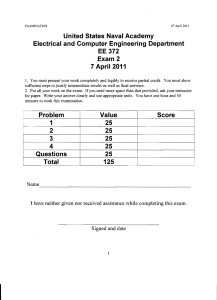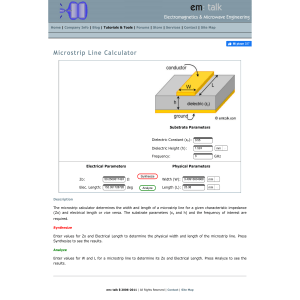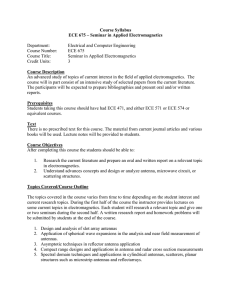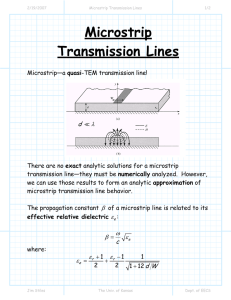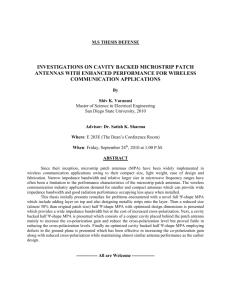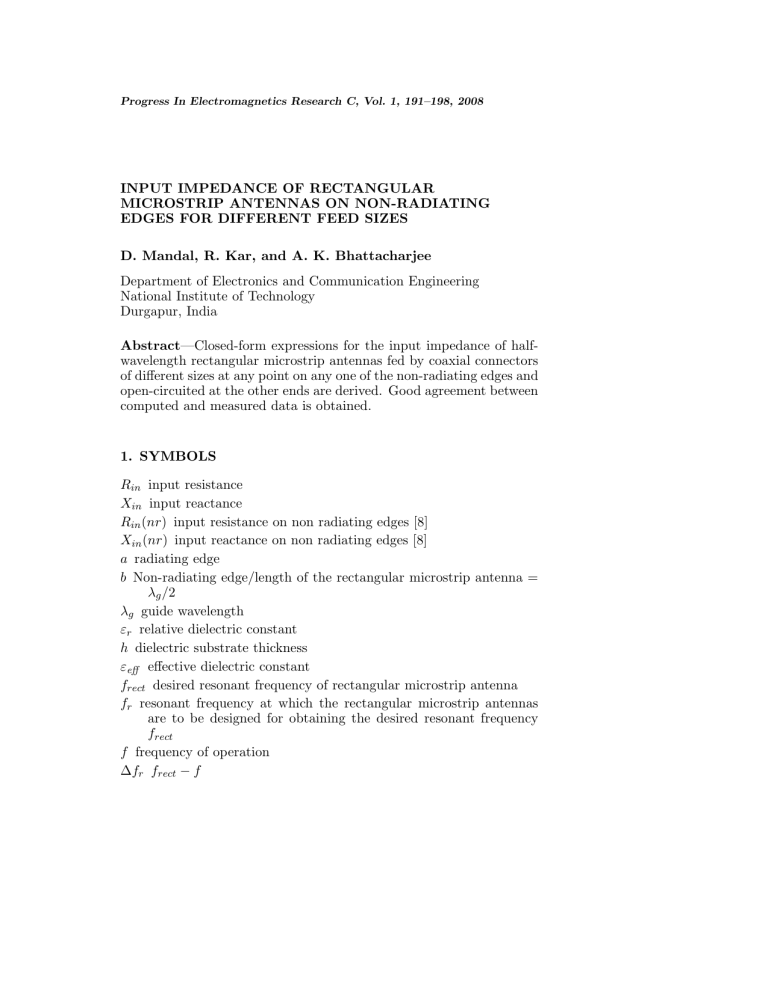
Progress In Electromagnetics Research C, Vol. 1, 191–198, 2008 INPUT IMPEDANCE OF RECTANGULAR MICROSTRIP ANTENNAS ON NON-RADIATING EDGES FOR DIFFERENT FEED SIZES D. Mandal, R. Kar, and A. K. Bhattacharjee Department of Electronics and Communication Engineering National Institute of Technology Durgapur, India Abstract—Closed-form expressions for the input impedance of halfwavelength rectangular microstrip antennas fed by coaxial connectors of different sizes at any point on any one of the non-radiating edges and open-circuited at the other ends are derived. Good agreement between computed and measured data is obtained. 1. SYMBOLS Rin input resistance Xin input reactance Rin (nr) input resistance on non radiating edges [8] Xin (nr) input reactance on non radiating edges [8] a radiating edge b Non-radiating edge/length of the rectangular microstrip antenna = λg /2 λg guide wavelength εr relative dielectric constant h dielectric substrate thickness εeff effective dielectric constant frect desired resonant frequency of rectangular microstrip antenna fr resonant frequency at which the rectangular microstrip antennas are to be designed for obtaining the desired resonant frequency frect f frequency of operation ∆fr frect − f 192 Mandal, Kar, and Bhattacharjee d diameter of the feed size in inches This paper shows the effect of feeding point at the edge (specially at the non-radiating edge). When the rectangular microstrip antennas are fed inside, the input impedance decreases. 2. INTRODUCTION Microstrip antennas of different configurations like square, rectangular, circular, trapezoidal, elliptical, etc. are widely used because of their many advantages over conventional antennas such as low cost, light weight, reproducibility, ease of fabrication, etc. Several authors have studied [1–5] different characteristics on microstrip antennas. Closedform expressions have been developed [6–8] for the input impedance of rectangular microstrip antennas. This communication attempts the development of empirical expressions for the input impedance of halfwavelength rectangular microstrip antennas for different feed sizes. 3. DESIGN A number of rectangular microstrip antennas of various a/h ratios and of length λg /2 and fed at any point on any one of the non-radiating edges by coaxial connectors, were constructed on PTFE substrates of different εr and h at the center frequency ranging from 1 to 10 GHz as shown in Figure 1. The values of λg /2 were calculated from [9]. Figure 1. Rectangular microstrip antenna. 4. MEASUREMENTS Rin and Xin of the rectangular microstrip antennas were measured over a range of frequencies centered around desired resonance frequency by an HP 8410B network analyzer connected to an HP 9000 computerized set-up. Progress In Electromagnetics Research C, Vol. 1, 2008 193 5. EMPIRICAL EXPRESSIONS FOR frect frect values observed from the network analyzer for different feed sizes were different from fr because of the fringing field. frect values were plotted with the fr values with a/h, εr , |y| and d as parameters as shown in Figure 2. Using curve fitting technique [10], the following expression was obtained relating the frect and fr : √ εeff 19 + a/b d+0.157 b/2 − |y| frect = fr log10 1− 1− 2 14.33εr 6.32b d0.32 (1) Equation (1) has been developed with reference to the co-ordinate axis of Figure 3. frect values calculated with d = 1/16 , using expression (1) were compared with the measured data of Kundu et al. [8] in Figure 4. The agreement was found to be excellent. Figure 2. frect versus fr plot for various εr , a/h, |y|, and d values. Figure 3. Coordinate system used in the analysis showing |y|. 194 Mandal, Kar, and Bhattacharjee Figure 4. frect versus fr plot for εr = 2.55, a/h = 10, h = 0.3048, |y| = 0.3 cm, and d = 1/16 . 6. EMPIRICAL EXPRESSIONS FOR Rin AND Xin Rin and Xin values measured from the network analyzer were plotted as a function of f , with εr , frect , a/h, |y|, and d as parameters. Some typical plots are shown in Figures 5 and 6. By the principle of curve fitting technique, the following expressions were obtained. √ d + 0.06 Rin (nr) (2) Rin = d0.42 and Xin = d − 0.15 √ + 1.35 Xin (nr) d (3) Where, Afrect εr ε2r + 49.5 Rin (nr) = a + 23 cos(∆fr ) h 6123.6 1 + 943.98(εr − 2.55)|∆fr |2.6 and 1+ 2.8 |∆fr | (4) a + 8.5 + 23 sin(∆fr ) Bfrect εr h Xin (nr) = 5588.77 (|∆fr | + 0.005) ε2r (5) Progress In Electromagnetics Research C, Vol. 1, 2008 195 Figure 5. Rin versus frequency plot for εr = 6, a/h = 8, h = 0.254, |y| = 0.2 cm, and d = 1/8 . Figure 6. Xin versus frequency plot for εr = 6, a/h = 8, h = 0.254, |y| = 0.2 cm, and d = 1/8 . b − |y| 2 1 − A = 3.83b and (6) b − |y| 2 1 − B= 7.21b In the above equations frect and ∆fr are expressed in GHz and −0.05 ≤ ∆fr ≤ +0.05 2.55 ≤ εr ≤ 10 1.0 ≤ fr ≤ 10.0 1/16 ≤ d ≤ 1/6 (7) 196 Mandal, Kar, and Bhattacharjee Figure 7. Rin and Xin versus frequency plot for εr = 10, a/h = 15, h = 0.154, |y| = 0.3 cm, and d = 1/16 . 7. CALCULATION OF Rin AND Xin Rin and Xin values of a rectangular microstrip antenna fabricated on a dielectric substrate having εr within a certain range of values and for a frequency range of ±0.05 Ghz around frect , fed at any point on any one of the non-radiating edges by coaxial connectors of different sizes may be calculated as follows : Step 1. Substitute the value of the fr , |y| and d and obtain the corresponding value of frect from equation (1). Step 2. Compute the values of Rin and Xin from equations (2) and (3) respectively, with the known values of frect calculated in step 1. 8. RESULT The theoretical values of Rin and Xin for the rectangular microstrip antennas were calculated using equations (1)–(3) and were compared with the measured data of Kundu et al. [8]. One typical plot is shown in Figure 7. The agreement was found to be excellent. 9. CONCLUSIONS Empirical expressions for the computation of the input impedance of half-wavelength rectangular microstrip antennas fed by coaxial connectors of different sizes at any point on any one of the nonradiating edges have been developed. The advantages of this method are that it can be used by practically any antenna designer without any Progress In Electromagnetics Research C, Vol. 1, 2008 197 background in this area and that the computation time is negligible small. ACKNOWLEDGMENT The authors gratefully acknowledge ETCE Department, JU, Kolkata32, West Bengal, India for providing measurement facilities. REFERENCES 1. Saed, M. and R. Yadla, “Microstrip-fed low profile and compact dielectric resonator antennas,” Progress In Electromagnetics Research, PIER 56, 151–162, 2006. 2. Chair, R., A. A. Kishk, K. F. Lee, C. E. Smith, and D. Kajfez, “Microstrip line and cpw fed ultra wideband slot antennas with u-shaped tuning stub and reflector,” Progress In Electromagnetics Research, PIER 56, 163–182, 2006. 3. Shynu, S. V., G. Augustin, C. K. Aanandan, P. Mohanan, and K. Vasudevan, “Design of compact reconfigurable dual frequency microstrip antennas using varactor diodes,” Progress In Electromagnetics Research, PIER 60, 197–205, 2006. 4. Guney, K. and N. Sarikaya, “Resonant frequency calculation for circular microstrip antennas with a dielectric cover using adaptive network-based fuzzy inference system optimized by various algorithms,” Progress In Electromagnetics Research, PIER 72, 279–306, 2007. 5. Liu, S. F., X. W. Shi, and S. D. Liu, “Study on the impedance-matching technique for high-temperature superconducting microstrip antennas,” Progress In Electromagnetics Research, PIER 77, 281–284, 2007. 6. Bhattacharjee, A. K., S. R. Bhadra Chaudhury, D. R. Poddar, and S. K. Chowdhury, “Equivalence of impedance and radiation properties of square and circular microstrip patch antennas,” Proc. IEE, Pt. H, 1989. 7. Deb, D., A. Gupta, S. Das, D. Patil, and A. K. Bhattacharjee, “Empirical expressions for the input impedance of rectangular microstrip antennas,” Microwave and Optical Technology Letters, Vol. 4, No. 6, 222–224, 1991. 8. Kundu, T. R., R. Kar, S. Chatterjee, N. Hazra, H. Chakraborty, A. Kesh, J. Chakraborty, T. Sengupta, S. Roy, and A. K. Bhattacharjee, “Input impedance of rectangular microstrip antennas 198 Mandal, Kar, and Bhattacharjee on non-radiating edges,” Microwave and Optical Technology Letters, Vol. 33, No. 1, 28–31, 2002. 9. Schneider, M. V., B. Glance, and W. F. Bodtmann, “Microwave and millimeter wave hybrid integrated circuits for radio systems,” Bell System Technical Journal, 1703–1725, 1969. 10. Arlinghaus, S. L., Practical Handbook of Curve Fitting, CRC Press, 1994.
